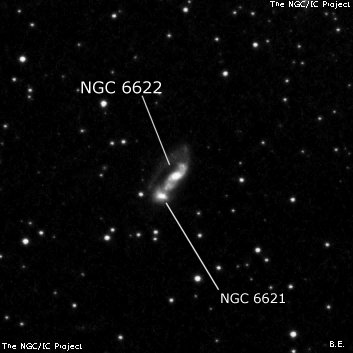
Lewis Swift discovered NGC 6622 = Sw. I-96 on 2 Jun 1885, although his son Edward was credited with the discovery of NGC 6621 = Sw. I-95. Apparently Lewis took a look in the eyepiece and noticed the smaller southeast component of this double galaxy. His position is 18 sec of RA too far east. Swift found the close pair again on 11 Aug 1885 and reported the discovery again in his second list (II-65 and II-66). Dreyer combined both observations in the NGC. Howe measured an accurate micrometric position, though called this galaxy NGC 6621 as Swift's position is slightly south of NGC 6622.
400/500mm - 17.5" (6/11/88): faint, very small, possibly round. Forms an interacting double system with NGC 6621 and visually both galaxies appear enveloped in a common envelope with NGC 6621 just 35" NW.
900/1200mm - 48" (5/5/16): at 610x and 697x; fairly bright, small, slightly elongated E-W, 25"x20", high surface brightness, very small intense core. A mag 15 star is 0.6' E. NGC 6622 and 6621 form a spectacular interacting pair (Apr 81 = VV 247) with NGC 6622 fully merged on the southeast end of this trainwreck. The cores of the two galaxies are separated by 40". A small knot is clearly visible directly on a line between the two cores [16" NW of NGC 6622]. The HST image reveals this is a prominent blue star-forming complex at the edge of the two galaxies. The amazing tidal tail of NGC 6621 that parallels the galaxy on the east side extends as far south as NGC 6622.
48" (10/22/11): at 488x, NGC 6622 appears bright, fairly small, slightly elongated, 30"x25", sharply concentrated with a bright core that increases to the center. Merged with NGC 6621 on the NW side. A mag 15.5 star lies 35" due east.
Notes by Steve Gottlieb